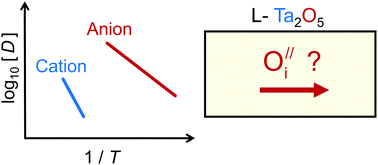A SIMS study of cation and anion diffusion in tantalum oxide
Abstract
Ion transport in ceramics of the low-temperature phase of tantalum pentoxide, L-Ta2O5, was examined by means of diffusion experiments and subsequent analysis of diffusion profiles with time-of-flight secondary ion mass spectrometry (ToF-SIMS). 18O/16O isotope anneals were used to investigate oxygen diffusion, and oxygen tracer diffusion coefficients were obtained for the temperature range of 623 ≤ T/K ≤ 873 at an oxygen partial pressure of pO2 = 0.2 bar and for the oxygen partial pressure range of 10−2 ≤ pO2/bar ≤ 100 at a temperature of T = 723 K. Cation diffusion in Ta2O5 was probed by using chemically similar niobium as the diffusant (in the absence of stable tantalum isotopes). Thin films of Nb2O5 were deposited onto Ta2O5 ceramics; diffusion anneals yielded niobium diffusion coefficients for the temperature range of 1073 ≤ T/K ≤ 1223 at an oxygen partial pressure of pO2 = 0.2 bar. Comparison of the measured diffusion coefficients strongly suggests that oxygen is many orders of magnitude more mobile than niobium in L-Ta2O5 at these temperatures and at pO2 = 0.2 bar. The electrical conductivity was also determined in the range 950 ≤ T/K ≤ 1200 and 10−23 ≤ pO2/bar ≤ 10−2. Considered together with the measured diffusion coefficients, the conductivity data indicate that under oxidising conditions conduction is due to oxygen ions above T = 1090–1130 K and due to electron holes below this temperature range. Point-defect models are presented that are consistent with these transport data and with conductivity data in the literature. They suggest that under oxidising conditions oxygen interstitials are the majority ionic charge carriers in L-Ta2O5. The implications for resistive switching devices are discussed.



 Please wait while we load your content...
Please wait while we load your content...